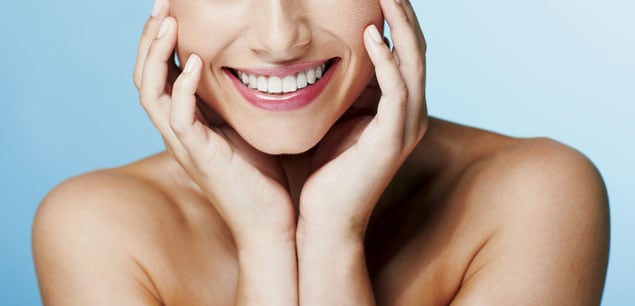Tried and True: Custom Trays
What’s the surest way to whiten teeth?
“Peer-reviewed studies say the most effective is when custom mouth trays are made in a dental office and a bleaching solution is given to the patient,” DC dentist Michael Blicher says. The solution, he explains, is “put into the trays and people wear them from two to eight hours a night. In a week, they should see an eight-shade change.”
Unlike drugstore whitening kits with one-size-fits-all trays, custom versions—which average $250 to $500 and can be reused—fit the mouth exactly. “Whitening is dependent on the contact of solution to the teeth,” Blicher says. It also depends on patients using the trays: Some find them uncomfortable and quit. A tip for anyone who has suffered sensitivity while bleaching: Brush with a toothpaste for sensitive teeth starting two weeks before.
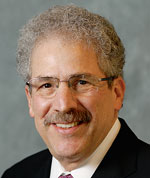
EXPERT ADVICE: DR. MICHAEL BLICHER
“People tend to want their teeth too white. When the teeth are whiter than the whites of the eyes, it draws your attention from looking someone straight in the eyes to looking someone straight in the teeth.”
Fastest Whitening—With a Catch
In-office bleaching can give the quickest, most dramatic result. A patient spends 60 to 90 minutes in a dentist’s chair with peroxide on his or her teeth and, Blicher says, will “walk out and look really, really white.” But the process dries teeth out; as they rehydrate, they can “rebound” or fade. In-office bleaching, which averages $500 to $800, can jump-start whitening—some people do it before a big event, then follow with tray whitening to prevent rebounding.
Because in-office bleaching uses a high concentration of peroxide—about 30 percent, versus 10 to 15 for trays and 3 to 10 for over-the-counter kits—it can cause the most tooth sensitivity. Gums are protected during the procedure to prevent burning.
Most dentists say that all in-office bleaching procedures work pretty much the same way. One process, Kör, promises “low to no” sensitivity (although some online reviewers still report sensitivity). DC dentist Thomas Sokoly, who offers Kör, says that’s because the procedure includes a more effective desensitizer.
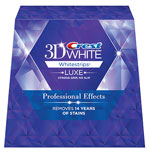
Time Versus Money: White Strips
While office bleaching can lighten in a day, over-the-counter strips—which work by keeping solution on the teeth for an extended period—take longer but are cheaper. “The mechanism is the same,” says Dr. Jack Ringer, president of the American Academy of Cosmetic Dentistry. “You will get the same result if you use them long enough.” Ringer recommends only strips approved by the American Dental Association. Crest’s 3D White Professional Effects Whitestrips With Advanced Seal were the top pick in a 2012 Good Housekeeping review. The downsides: Strips treat only front teeth, and some won’t completely cover crooked or long teeth.
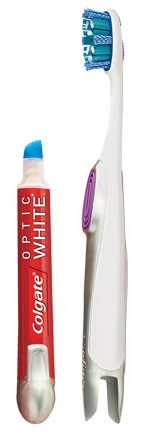
Convenient Date-Night Fix?
Touchup pens with hydrogen peroxide—such as Colgate’s Optic White Toothbrush & Built-in Whitening Pen and Paula’s Choice Brighten Up—promise to add instant sparkle to a smile. But saliva quickly rinses off the solution, so any change would be minimal. They may work best to maintain already-whitened teeth. “Some of my patients, if they’ve had a couple cups of coffee, might use a pen before a meeting,” says Sokoly, whose office sells the Philips Zoom! pen. Some pens, DC dentist Brian Gray cautions, contain a pigment such as titanium dioxide—you’re not so much whitening teeth as painting them white.
It’s Just Toothpaste
Drugstore shelves are full of “whitening” toothpastes. Which begs a question: Isn’t the idea of any toothpaste to remove surface stains? “They’re almost all the same, if you look at the ingredients,” Gray says. “The results are exactly the same.” Plus, Ringer says, “hydrogen peroxide in toothpaste is not going to work unless the person spends hours with it on their tooth. Otherwise it’s not going to absorb.”
Most Natural: Eat Right
Crunchy foods such as raw apples, celery, and carrots scrub teeth as you chew them. You won’t turn mushroom-hued teeth white, but eating fruits and veggies can’t hurt, right? Another simple way to keep teeth from getting dull: Brush your teeth or rinse your mouth with water after consuming staining foods like beets, berries, and black tea.

EXPERT ADVICE: DR. GEORGE KESTEN
“You need to have realistic expectations. The younger the person, the more the teeth will bleach. The older the person, the more the teeth will not change. Any crowns or fillings will not change color from the bleach.”
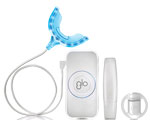
Get Glowing Teeth?
More whitening products now combine a gel with a blue light—there’s even a new toothbrush with an LED light. The premise is that the light speeds whitening, but research shows that lights have no effect. “It’s certain that the light does nothing,” Gray says. “It’s a gimmick.”
A popular device with a light, Glo Brilliant, has many fans, and our tester found that it did lighten her teeth. One reason it works is that the tray keeps the gel on the teeth. Jonathan Levine, a cofounder of Glo Science, agrees that light alone does nothing but says the heat from his device accelerates whitening—meaning you need to wear it for only short periods versus hours for custom trays. He says the shorter treatment time—four eight-minute sessions over five days—helps lead to less sensitivity. Some dentists say such heat could dry out teeth, making them appear whiter temporarily, but Levine says his gel is hydrating, so that’s not an issue.
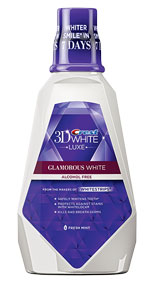
All a Wash?
The newest things in drugstores are whitening mouthwashes, which typically contain hydrogen peroxide. While they won’t lighten teeth dramatically, they can remove surface stains. A bonus, according to Gray: They can improve gum health. Not all taste great; Gray says Crest’s 3D Glamorous White is the best-tasting. He adds to stay away from rinses with cetylpyridinium chloride—which, ironically, can stain teeth.
Don’t Put Money Down the Drain
If you’re doing any whitening, whether strips or custom trays, try to avoid pigmented food and drink, such as soy sauce and cranberry juice, during the week or two of treatment, when teeth are more porous. Can’t give up cola, red wine, or tea? Use a straw. Another way to boost effectiveness: Do any whitening a week after a professional cleaning. “You’ve cleaned off the surface stains, and now the enamel is more receptive,” Gray says.
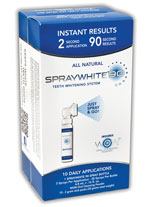
Two Easy At-Home Treatments
For ease of use with quick results, we liked Supersmile. Both the Supersmile Professional Activating Rods—$39 for a box of 12 through the Grooming Lounge (groominglounge.com)—and the Supersmile Professional Whitening System ($36) were simple to use and had our tester’s teeth whiter within four days. The first step involves rubbing the Activating Rod “gel” over your teeth for 30 seconds (it has a slight mint taste and comes with an applicator); the second step is as easy as brushing. The Professional Whitening System has two solutions, a clear accelerator and a minty white toothpaste; put a dab of each on a dry toothbrush and you’re good to go. You repeat the process once in the morning and once in the evening.
DC prosthodontist Benjamin Watkins says his office has had success with a new product called Spraywhite 90 (pictured at right), from Wow Oral Care. We found that it did lighten teeth—in our tester’s case just two shades, within the “two to five” advertised. Still, it was easy and fast, with minimal tooth sensitivity. You simply squirt Spraywhite into your mouth, swish for 30 to 90 seconds, then spit it out. Next, you pour a small packet of Powder Oral Rinse on your tongue and swish that for 30 to 90 seconds. A 60-day kit is $129, and it comes with a maintenance spray to use after you’ve reached the desired whitening. (Readers can save 25 percent with the code REF25 at carsonlaboratories.com.)

EXPERT ADVICE: DR. BRIAN GRAY
“The best way to whiten teeth still is to limit the intake of staining foods and drinks. If you’re ready to cut espresso, red wine, cranberry juice, and so on out of your diet, you may have really white teeth—but not be much fun at the party.”
Best Way to Fake It
A trick to making yellow teeth look whiter is to wear lipstick with a blue tone. “Bright-shimmer pale pink, sheer hot pink, berry, pinkish red, royal purple, deep plum, rich red, and nude shade with gloss all help pearly-whites appear brighter,” says Carl Ray, Michelle Obama’s makeup artist, who advises avoiding colors with an orange or yellow cast.
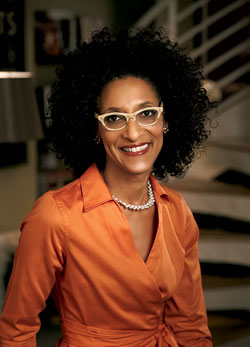
Buzziest Method: Oil Pulling
Can swishing oil in your mouth whiten teeth? The Ayurvedic practice of “oil pulling” has been around thousands of years but has gotten buzz of late. Studies show that swirling vegetable oil through teeth reduces plaque and bad breath. Proponents believe the oil also “pulls” toxins out of the body to help with everything from acne to insomnia to arthritis, but evidence is anecdotal. Says Gray: “While swishing coconut oil can’t hurt, there is zero science to support any benefits other than possibly improved gum health.”
Tell that to its fans. DC chef Carla Hall, a cohost of TV’s The Chew, says that after two months of oil pulling, “my skin has been so supple, my sinuses have been so clear, I have so much more energy.” (She drinks a quart of water after oil pulling—which could explain the supple skin.) Hall alternates between sesame and coconut oil: “I do think my teeth are a little lighter after using coconut oil.”
Oil pulling requires commitment: You swish a tablespoon of oil for up to 20 minutes a day. Hall does other things (washing dishes, hula-hooping) while she swishes.
This article appears in the May 2014 issue of Washingtonian.

